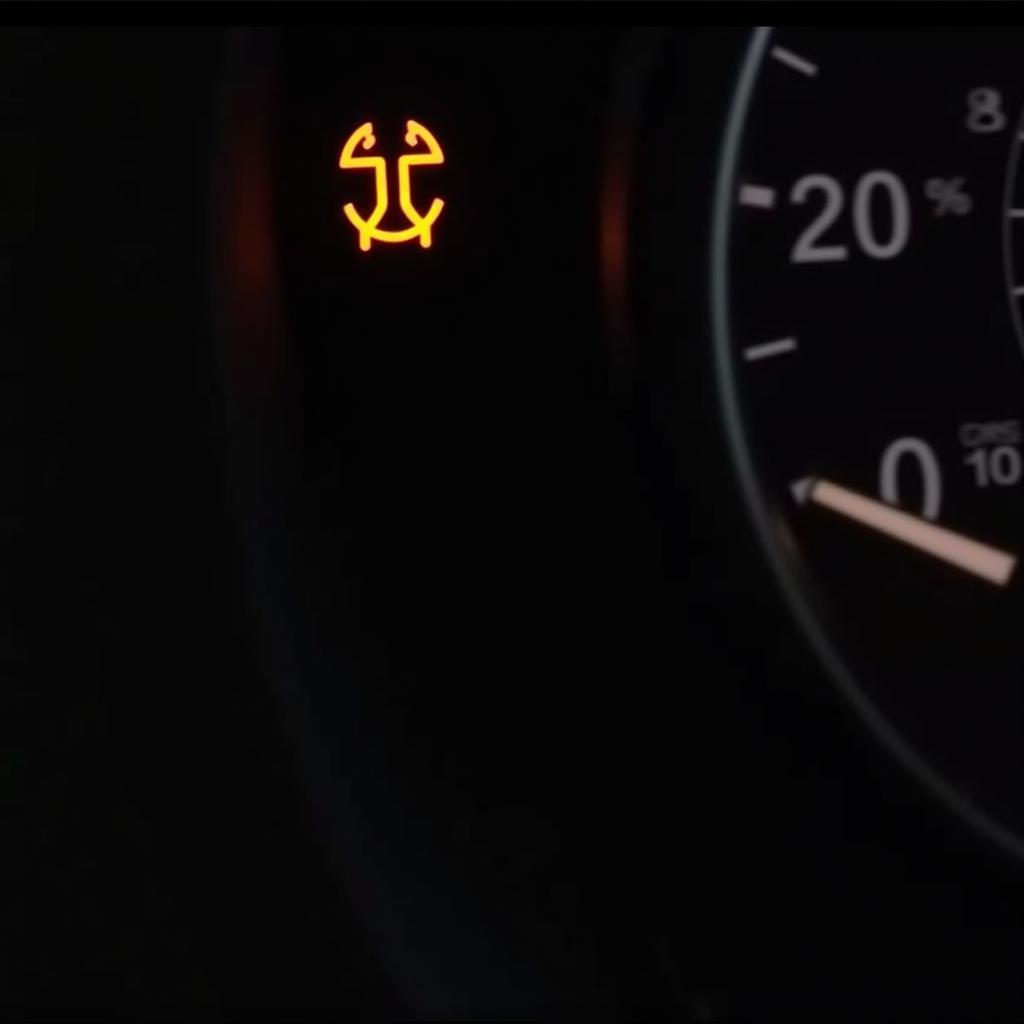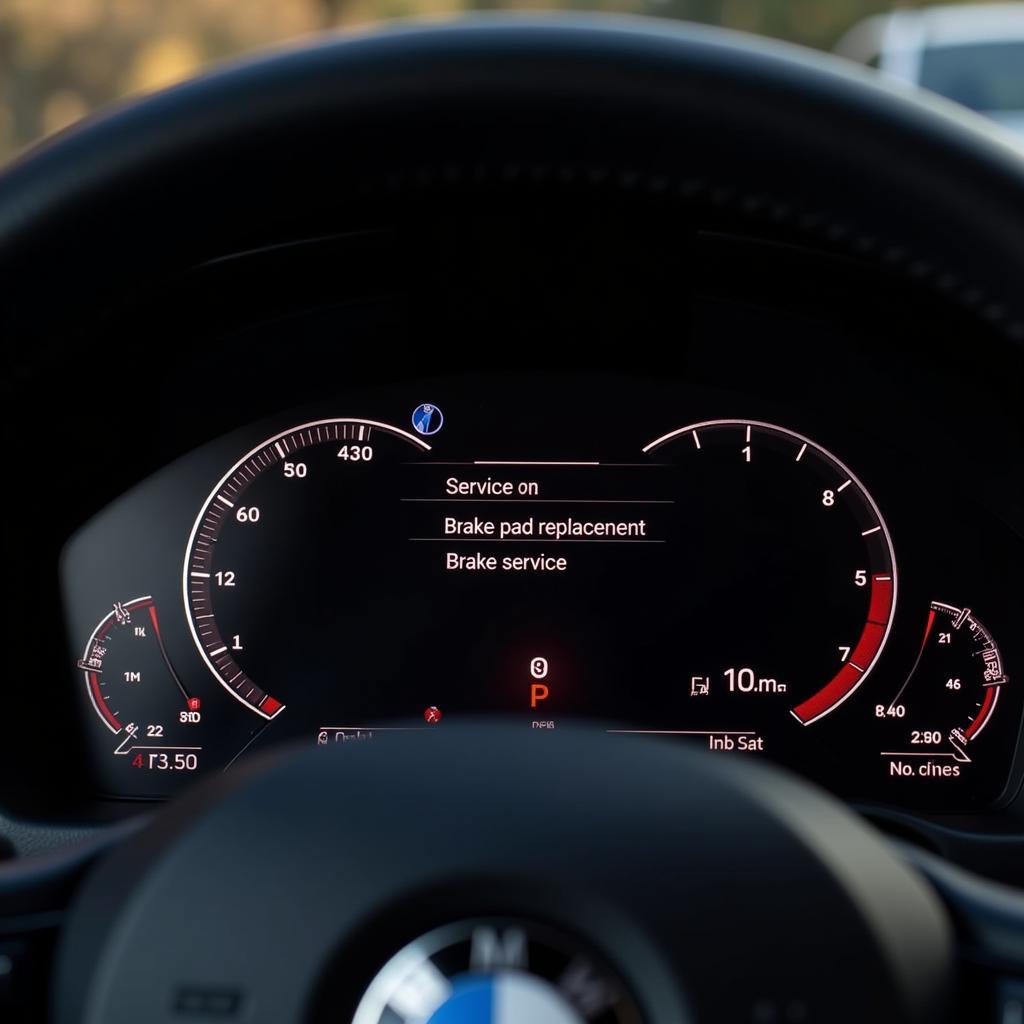The brake pad warning light on your BMW dashboard is a crucial safety feature. When illuminated, it signals that your brake pads have worn down and need replacing. While simply replacing the brake pads usually addresses the issue, you might need to manually reset the brake pad warning light. This guide provides a comprehensive walkthrough on how to reset brake pad warning on BMW, covering various models and model years.
 BMW brake pad warning light
BMW brake pad warning light
Understanding the BMW Brake Pad Warning System
BMW vehicles utilize sophisticated sensor technology to monitor brake pad wear. These sensors, typically embedded within the brake pad itself, work in conjunction with your BMW’s onboard computer system. When the brake pad material wears down to a predetermined level, the sensor triggers the brake pad warning light on your dashboard.
Why Resetting the Brake Pad Warning Light is Important
While replacing your brake pads is the priority, resetting the warning light is essential for several reasons:
- Confirmation of Repair: Resetting the light confirms that the brake pad issue has been addressed and the system is functioning correctly.
- System Recalibration: The reset procedure allows the BMW’s computer system to recalibrate and recognize the new brake pads.
- Avoiding False Warnings: Failure to reset can lead to the warning light remaining illuminated even after replacing the brake pads.
Methods to Reset BMW Brake Pad Warning Light
There are two primary methods you can use to reset the brake pad warning light on your BMW:
1. Resetting Using the Instrument Cluster
For many BMW models, you can reset the brake pad warning light directly through the instrument cluster:
- Turn on the ignition: Turn the key to position one or two – don’t start the engine.
- Access the Service Menu: Navigate to the service menu using the buttons on your steering wheel or instrument cluster. The exact buttons and menu navigation might vary depending on your BMW model. Refer to your owner’s manual for specific instructions.
- Select “Brake Pad Replacement”: Once in the service menu, locate and select the option related to “brake pad replacement” or “brake service.”
- Follow the On-Screen Prompts: Your BMW’s system will guide you through a series of prompts. This usually involves confirming the reset and acknowledging that the brake pads have been replaced.
 Resetting brake pad warning on BMW instrument cluster
Resetting brake pad warning on BMW instrument cluster
2. Resetting Using a Diagnostic Tool
For certain BMW models, particularly newer ones, you might need a specialized diagnostic tool to reset the brake pad warning light:
- Connect the Diagnostic Tool: Connect a compatible BMW diagnostic tool to your vehicle’s OBD-II port, usually located under the dashboard on the driver’s side.
- Access the Brake System Module: Using the diagnostic tool’s software, navigate to the module responsible for the brake system.
- Select “Brake Pad Reset” or Similar: Look for an option specifically labeled as “brake pad reset” or a similar term.
- Follow the Tool’s Instructions: The diagnostic tool will provide instructions on completing the reset procedure. This typically involves confirming the action and clearing any stored fault codes.
Tips for Successful Brake Pad Warning Light Reset
- Consult Your Owner’s Manual: Always refer to your BMW’s owner’s manual for model-specific instructions and precautions.
- Ensure Proper Brake Pad Replacement: The reset procedure will only be successful if the brake pads have been replaced correctly.
- Seek Professional Assistance: If you’re uncomfortable performing the reset yourself or encounter difficulties, don’t hesitate to consult a qualified BMW mechanic or service center.
When to Consult a Professional
While resetting the brake pad warning light can often be done DIY, certain situations warrant professional help:
- Persistent Warning Light: If the warning light remains on after attempting the reset, it might indicate a deeper issue with the braking system.
- Unusual Noises or Sensations: If you experience grinding noises, vibrations, or pulling to one side while braking, it’s crucial to have your brakes inspected by a professional immediately.
“Ignoring brake warning lights or delaying brake service can lead to serious safety hazards,” says Jake Carter, a seasoned BMW mechanic with over 15 years of experience. “Regular maintenance and timely repairs are vital for optimal brake performance and overall vehicle safety.”
FAQs
Q: How often should I replace my BMW’s brake pads?
A: Brake pad lifespan varies greatly depending on driving style and conditions. However, it’s generally recommended to have them inspected every 10,000 miles and replaced as needed.
Q: Can I drive with the brake pad warning light on?
A: While you might be able to drive for a short distance, it’s highly discouraged. Driving with worn-out brake pads significantly reduces braking efficiency and can lead to rotor damage or brake failure.
Q: Can I reset the brake pad warning light myself?
A: Yes, the reset procedure can often be done DIY using the methods outlined above. However, always refer to your owner’s manual and proceed with caution.
Q: What if the reset procedure doesn’t work?
A: If the warning light persists, there might be a fault in the sensor system or another issue with the brakes. Consult a qualified BMW mechanic for diagnosis and repair.
Conclusion
Understanding how to reset the brake pad warning on your BMW is a valuable skill for any BMW owner. By familiarizing yourself with the methods outlined in this guide and heeding professional advice when needed, you can ensure the optimal function and longevity of your BMW’s braking system, contributing to a safer and more enjoyable driving experience. Remember, neglecting brake maintenance can have serious consequences – prioritize your safety and address any brake-related concerns promptly.


